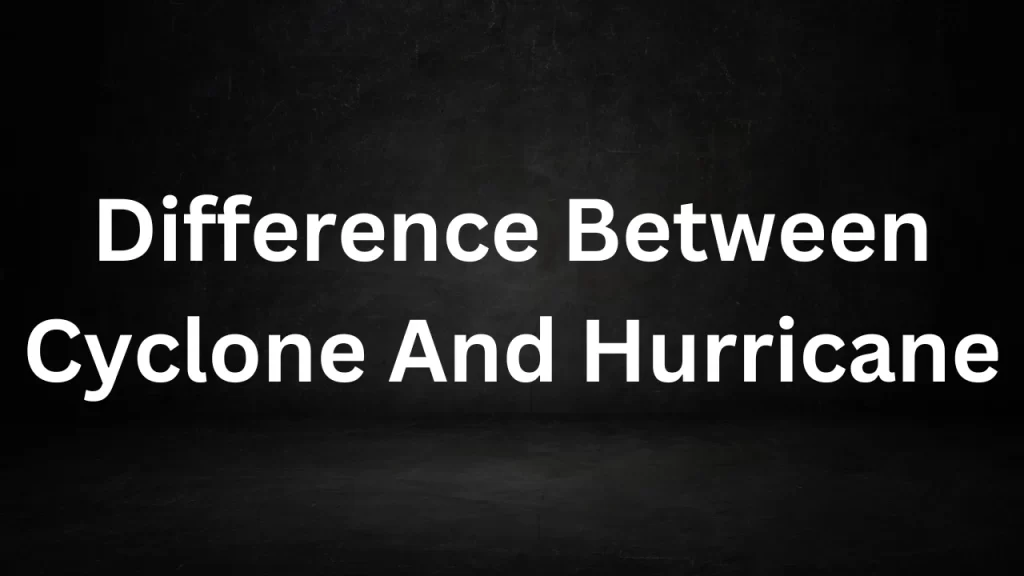Difference Between Cyclone And Hurricane: Cyclones and hurricanes are both powerful weather phenomena known for their destructive potential, but they are given different names based on their location and characteristics.
These storms are essentially the same natural disasters, but they are called by different names in different parts of the world. In this article, we will explore the key differences between cyclones and hurricanes.

Difference Between Cyclone And Hurricane
Cyclone:
1. Geographic Location:
- Cyclones are tropical storms that occur in the Indian Ocean and the South Pacific Ocean.
- In the South Pacific, they are known as cyclones.
- In the Indian Ocean, they are referred to as cyclones as well.
2. Nomenclature:
- Cyclones are typically named by the meteorological agencies of the countries affected by them.
- Names are assigned alphabetically, often based on a predetermined list of names for the region.
3. Wind Direction:
- In the Southern Hemisphere, cyclones rotate counterclockwise (anticlockwise).
- In the Northern Hemisphere, they rotate clockwise.
4. Notable Cyclones:
- Some notable cyclones include Cyclone Tracy, which devastated Darwin, Australia in 1974, and Cyclone Phailin, which hit the eastern coast of India in 2013.
Hurricane:
1. Geographic Location:
- Hurricanes occur in the Atlantic Ocean and the northeastern Pacific Ocean.
- In the Atlantic, they are known as hurricanes.
- In the northeastern Pacific, they are referred to as hurricanes as well.
2. Nomenclature:
- Hurricanes are named according to a predetermined list of names established by the World Meteorological Organization (WMO).
- Names are assigned alphabetically and alternate between male and female names.
3. Wind Direction:
- In the Northern Hemisphere, hurricanes rotate counterclockwise.
- In the Southern Hemisphere, hurricanes rotate clockwise.
4. Notable Hurricanes:
- Some famous hurricanes include Hurricane Katrina, which struck the Gulf Coast of the United States in 2005, and Hurricane Maria, which devastated Puerto Rico in 2017.
Similarities:
- While cyclones and hurricanes have distinct names and are found in different ocean basins, they share several common characteristics:
- Formation: Both cyclones and hurricanes originate as tropical storms over warm ocean waters, where they gain energy from the heat and moisture in the atmosphere.
- Destructive Potential: Both can intensify into extremely powerful and destructive storms, with high winds, heavy rainfall, and the potential for storm surges that can lead to coastal flooding.
- Tracking and Prediction: Meteorological agencies closely monitor the development and path of both cyclones and hurricanes, providing advance warning to potentially affected regions.
In conclusion, the main difference between cyclones and hurricanes lies in their geographic locations and the names used to refer to them in different parts of the world. Despite these variations, they share common characteristics and pose similar threats to coastal areas and communities, emphasizing the importance of preparedness and effective disaster response.
Read More
- Molecular Weight Of Na
- Molecular Mass Of O2
- Molecular Mass of H2
- Molecular Mass Of NH3
- Molecular Mass Of Ch4
Frequently Asked Questions (FAQs) Difference Between Cyclone And Hurricane
Q1: What is the primary difference between a cyclone and a hurricane?
A1: The primary difference between a cyclone and a hurricane is their geographic location and the terminology used to describe them. Cyclones are tropical storms that occur in the Indian Ocean and the South Pacific, while hurricanes are tropical storms that occur in the Atlantic Ocean and the northeastern Pacific. They are essentially the same meteorological phenomenon but are given different names based on their location.
Q2: How do the names of cyclones and hurricanes differ?
A2: Cyclones are typically named by the meteorological agencies of the countries affected by them, and names are often assigned alphabetically from predetermined lists for their respective regions. In contrast, hurricanes are named according to a predetermined list established by the World Meteorological Organization (WMO). The names for hurricanes are chosen internationally and alternate between male and female names.
Q3: Do cyclones and hurricanes rotate in the same direction?
A3: No, the direction of rotation of cyclones and hurricanes depends on their hemisphere. In the Northern Hemisphere, both cyclones and hurricanes rotate counterclockwise. In the Southern Hemisphere, they rotate clockwise. This is due to the Coriolis effect, caused by the Earth’s rotation, which influences the direction of motion in large-scale weather systems.
Q4: Are cyclones and hurricanes equally destructive?
A4: Both cyclones and hurricanes have the potential to be extremely destructive, with high winds, heavy rainfall, and the potential for storm surges that can lead to coastal flooding. The level of destruction depends on factors such as the storm’s intensity, size, and the vulnerability of the affected areas.
Q5: Can a cyclone turn into a hurricane or vice versa?
A5: Cyclones and hurricanes are essentially the same meteorological phenomenon, but they are given different names based on their location. While they can have similar characteristics, they do not spontaneously change from one to the other. They maintain their names and characteristics based on the ocean basin in which they form.
